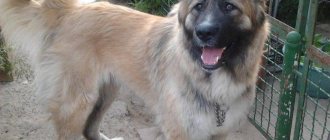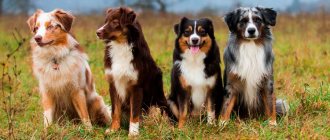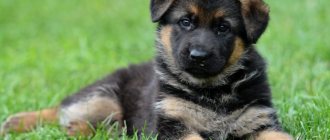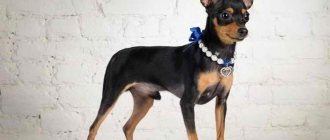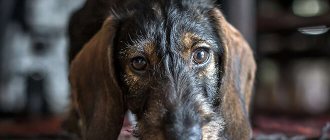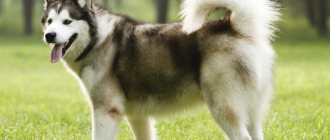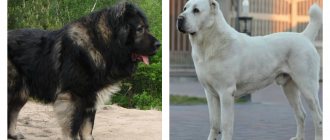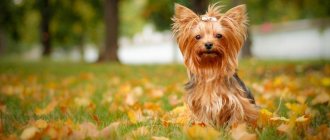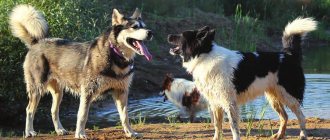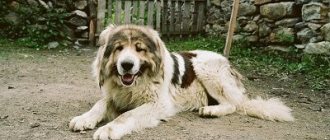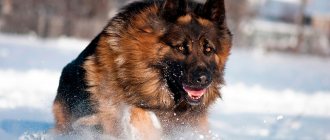The black-and-white color of German Shepherds is currently the most common color.
After all, red-black dogs are shown in films and advertising, and it is black-and-white shepherd dogs that can most often be seen in exterior rings.
It is not surprising that most people who decide to purchase a pet of this breed have developed a stereotype that a “German” must be black-haired.
What else is remarkable about such shepherd dogs, besides their winning and spectacular color?
Let's learn about everything from the article.
Origin story
Black-backed coloring did not originally exist among German Shepherds. Although, perhaps, already in the old days there were individuals of a zone-red color, which could conditionally be classified as animals with a weakened saddle.
But the ancestor of the breed, the famous Horand von Grafrath, was a zone-gray color and he consistently passed on this coat color to most of his descendants.
That is why in the first half of the 20th century, the zonal color predominated among German shepherds, however, later, along with gray, dogs with a reddish coat also appeared, which became the ancestors of the saddle-backed shepherd dogs.
The first “Germans” with such coat colors created a real sensation in the world of dog breeding.
Unlike the more modestly colored zonal shepherd dogs, due to the contrasting combination of reddish, brownish and black fur, they looked bright, elegant and unusual for their time.
IMPORTANT!
The new color quickly began to gain popularity, so that most breeders of show dogs began to breed mainly saddle-colored German shepherds.
Zone dogs, in general, turned from show beauties into working dogs, since in the exterior rings many of them lost to the more impressive-looking saddle-backed shepherd dogs.
By now, the saddle color of the “Germans” has long been considered a classic color . And thanks to the fact that such dogs are constantly featured in films, most lovers cannot even imagine that a shepherd dog could have a different coat color.
Eye and skin color
According to accepted standards, the iris of representatives cannot be black; dark tones are allowed. The shades of fur and eyes are not comparable; dark animals have light variants and vice versa.
Important! Cynologists believe that if the color of the irises and coat are combined, then such individuals look more attractive than their counterparts.
In the presence of a colorless, blurry color, pets have a darkish rim around the eyes and small blackish spots on the tongue. The skin of individuals has a gray-blue tone, with pink under the tan. The nose is painted in deep dark undertones.
Color variations
Description and photo of the pet
Despite the rather stretched body format, the dog does not look squat. The proportions of her body are harmonious and fit together well.
Moreover, even the slightest violation of them makes the animal not like a real shepherd:
- The length of the head from the tip of the nose to the occipital protuberance is approximately 40% of the height at the withers. In this case, the muzzle and the skull must be in proportions of 1:1, that is, be equal in length.
- The head is wedge-shaped when viewed from above and not too wide. Males usually have more massive heads than females.
- The ears are erect, medium in size, slightly rounded at the ends, having a triangular shape.
- The eyes are dark, oval, the gaze is quick-witted, intelligent and alert.
- The nose is black and quite large.
- The neck is set at approximately an angle of 45 degrees, strong, strong, with well-developed muscles, but, at the same time, devoid of even the slightest signs of excessive massiveness or coarseness.
- The withers are well defined, the back is slightly elongated and sloping towards the tail. The croup is also sloping.
- The tail is slightly curved, lowered when calm, and does not rise higher than the back when interested.
- The limbs are straight and strong. The hind legs are well muscled, slightly set back and somewhat longer than the front ones.
- The coat of black-backed German Shepherds can be quite short and harsh, or more elongated and relatively soft.
The shepherd must have strong and strong jaws with a full set of teeth, and an exclusively scissor bite.
Expert opinion
Kozhevin Semyon Kirillovich
Expert dog handler.
“The black-backed German Shepherd is a beautiful and stately working dog with a bright and impressive color. Such dogs are always popular at exhibitions and therefore are readily bred by professional breeders. Currently, the black saddle color is considered classic. But the fact that black-haired shepherd dogs make up the majority of the purebred population leads to the fact that people who get a shepherd dog for the first time get confused in numerous lines and, as a result, take a pet that is not suitable for them in character, temperament or working qualities.”
Genetics of German Shepherd colors
Black-backed German
Scientific research has studied the characteristics of selective selection and its influence on the color scheme. A large number of undertones are associated with the pigment melanin. Three genes influence the final color:
- black - “A”;
- tan and black - “AT”;
- zonal - “AW”.
A mixture of genes leads to different colors, and mutations at the gene level lead to color variations. Anything that does not fit the generally accepted standard is considered a defect and cannot be included in the breeding group and is not allowed at regional and international exhibitions.
Acceptable options for purebred individuals
Character of dogs
The black-haired German Shepherd is an intelligent, vigilant, attentive and very loyal dog to its owners. She is distinguished by courage, determination and distrust of strangers.
This is a reliable guard and bodyguard who cannot be deceived or bribed.
Impeccably obedient when properly trained, the shepherd will wait for the owner's command before pouncing on a stranger who seems suspicious to her.
At the same time, these dogs are quite capable of making their own decisions if the owner is not nearby.
At home, shepherd dogs are quite friendly: they treat all family members well, although they tend to consider only one person as the main owner.
The show-bred Black Sheepdog, in addition, has an innate ability to show itself in the best light during exhibition.
But in order for a pet to take first place, it must be taught from an early age the correct exhibition stance and walking in a straight line and in a circle.
Character, training and education
By its temperament, the German Shepherd is a fairly active and lively dog. It is not for nothing that it is bred mainly for sporting competitions. She has no deviations in psychological development and has a developed intellect.
As for education and training, they need to be done every day. It is best to train directly, rather than through someone else. This way the pet will feel the love of the owner and receive satisfaction from the training process.
The dog should always know its name and the place designated specifically for it. The animal must be taught this from the moment it appears in the family. When the pet is six months old, you can begin to undergo a general course of education and training.
If you don't train your shepherd, it can seriously harm other people. After all, this is a large animal with powerful teeth. In general, during the training process, the German Longhaired Shepherd is very smart and efficient. She is excellent at guarding the house and protecting the owner from outside attacks. In addition, the animal itself is very devoted and faithful. Also check out our materials about German Shepherd diseases and vaccinations.
Dimensions, weight and other distinctive features
The black-backed German Shepherd is a dog of above average height, with a height of 55 to 65 cm at the withers.
The weight of representatives of this breed, depending on gender, can range from 22 to 40 kg, but there are also larger “Germans” weighing up to 50 kg.
The main distinguishing feature of these dogs is the presence of a dark saddle-shaped spot covering the neck, shoulders, as well as the back and sides of the shepherd from the withers to the tail . The saddle cloth, or, as it is also called, the mantle, can be of various shapes and sizes.
It can also be either saturated, coal-black, or weakened - grayish or even brownish.
NOTE!
The main color, called tan, with black-and-white color comes in varying intensities: from light, yellowish, to very bright and rich, reddish-brown.
Most black-backed German Shepherds have more or less pronounced darkening on the face, often looking like a black mask.
The edging of the eyelids and lips are exclusively black.
Good pigmentation is mandatory for a dog of this color, since its absence indicates a weakened genotype in animals of this line.
Black and tan color
Such dogs may appear completely black due to the predominance of black color, pronounced black mask, and black undercoat. The overall dark tone is diluted only by brown strokes on the paws. There are 3 varieties of black and tan color - rich, darkened and weakened.
Important! The pale black and tan is often indistinguishable from the black zone, as it displays a large amount of black on a barely gray undercoat, brown/gray along the shoulder and along the top of the neck, and black markings on the toes and paws.
These German Shepherds are genetically predisposed to "fading" the black mantle: they convey a weakened color, although they themselves appear quite dark. It should be remembered that black and tan dogs always have a tan mark near the anus.
Return to content
Life expectancy and health
Black Sheepdogs live from 10 to 14 years on average, but under good conditions they can live longer.
This breed is not weak and sickly, however, these dogs may be predisposed to certain ailments , for example, such as :
- Diseases of the gastrointestinal tract.
- Allergies are usually food allergies.
- Inflammatory diseases of the ears.
- Skin diseases such as eczema or dermatitis.
- Hip dysplasia.
Shepherd dogs are also prone to gastric volvulus . Therefore, you need not to overfeed your pet and not allow him to move actively after eating for at least three hours.
Rules of care
It is enough to brush a black-backed German Shepherd 3 or 4 times a week, and when the pet sheds, then daily.
Considering that a dog leaves hair everywhere during shedding, we can recommend combing out the dying undercoat in advance, either with a special brush or with a furminator.
You need to bathe your dog once every 2-3 months, and you should use only shampoo intended for animals and, preferably, hypoallergenic.
You should clean your ears, eyes and teeth only when necessary, although you should examine them every day so as not to miss the onset of inflammation.
German Shepherds usually grind their claws down themselves . Therefore, the need to cut them may appear only when the dog does not walk much on hard surfaces.
Read more about caring for a German Shepherd here.
Non-standard colors of the “Germans”
In addition to the standard ones, there are various non-standard colors that were obtained as a result of uncontrolled crossing of German shepherds. Such animals are rejected and do not have the right to build an exhibition career or participate in breeding.
Among the most common non-standard colors are:
- white;
- ginger;
- grey;
- spotted;
- roan.
Regardless of the color of their coat, the animals bear the main characteristics of the breed and are considered one of the best guards and companions.
White
Light fur is the result of activation of a regressive gene in both parents. Such dogs are not albino, they have dark claws and brown eyes, as well as a black nose.
Ginger
Such dogs look impressive, but are not recognized by kennel clubs. The color intensity can vary, from fawn to brick red.
Grey
When the black color weakens, gray or blue puppies may appear in the litter. This is a striking color that looks very attractive, but these puppies are discarded.
Spotted
These are usually German Shepherd mixes. As a rule, the color is tricolor. White, red and black spots are scattered throughout the dog's body, like age spots.
Roan
Usually this shade appears with age, when the dog begins to “grey” and the hairs lose pigment and become lighter.
Despite the abundance of colors, German shepherds have always been very devoted and faithful pets, serving well and unquestioningly obeying their owner. The coloring does not detract from the qualities of the animal; the pets remain faithful and obedient. Of course, a person planning to build a dog's show career should look for a puppy with a standard coat color.
Similar articles
How to choose a Black Sheepdog?
When choosing a black-backed shepherd dog, you should not rush and take a puppy from the first litter. Before buying a shepherd, you need to decide what it is being purchased for: for exhibitions and breeding or for work?
Or maybe you need a future winner of a sports competition or a security guard for your home?
After this, you need to thoroughly study the information about all available nurseries or private breeders.
To do this, it is useful to look through breed forums, where you can often find more objective information than on brochures and advertisements for the sale of puppies.
Finally, having decided on a nursery, you need to study the pedigree of the litters available at that time or those planned for the near future.
It is also necessary to make sure that the parents of the future pet are free from hereditary diseases and have good working qualities and a stable psyche..
A good sign of this will be not only exhibition awards, but also medical certificates, as well as training diplomas.
Only after making sure that the father and mother of the future pet have desirable qualities that they are likely to pass on to their children can you go for a puppy.
When choosing a baby, you need to pay close attention to his character, temperament and quality of raising . The shepherd dog must be fairly well-fed, thick-footed and strong in appearance and, of course, completely healthy.
It should be taken into account that small black-backed shepherd dogs are black and tan and change color only after changing their puppy coat to an adult coat.
Black color
Despite the uniqueness of this color, some shepherds have brown hair on the hocks or between the toes, as well as gray undercoat on the shoulders and neck. According to the American breeder Maur Ray, who purposefully bred black dogs, the latter (if born from black sires in several generations) show a decrease in the percentage of blond hair until it disappears completely.
Some breeders deliberately breed with black shepherds to improve the pigmentation of the offspring, but this works if the pedigree includes shepherds of other dark colors. Often, the mating of a pale black-backed shepherd and a black shepherd produces a litter, where some of the puppies have a pale black-backed coat color . Dog handlers note that now there are almost no black (as well as zone-gray) German Shepherds left with an exemplary breed exterior. True, such dogs, thanks to the efforts of breeders, are gradually regaining their former glory and are increasingly winning prizes at exhibitions.
Return to content
